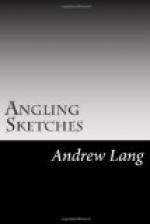After the little expanse of open shore had been fished over a few times, the trout there seemed to grow more shy, and there was a certain monotony in walking this tiny quarter-deck of space. So I went round to the west side, where the water-lilies are. Fish were rising about three yards beyond the weedy beds, and I foolishly thought I would try for them. Now, you cannot overestimate the difficulty of casting a fly across yards of water-lilies. You catch in the weeds as you lift your line for a fresh cast, and then you have to extricate it laboriously, shortening line, and then to let it out again, and probably come to grief once more.
I saw a trout rise, with a huge sullen circle dimpling round him, cast over him, raised him, and missed him. The water was perfectly still, and the “plop” made by these fish was very exciting and tantalising. The next that rose took the alder, and, of course, ran right into the broad band of lilies. I tried all the dodges I could think of, and all that Mr. Halford suggests. I dragged at him hard. I gave him line. I sat down and endeavoured to disengage my thoughts, but I never got a glimpse of him, and finally had to wade as far in as I dared, and save as much of the casting line as I could; it was very little.
There was one thing to be said for the trout on this side: they meant business. They did not rise shyly, like the others, but went for the fly if it came at all near them, and then, down they rushed, and bolted into the lily-roots.
A new plan occurred to me. I put on about eighteen inches of the stoutest gut I had, to the end I knotted the biggest sea-trout fly I possessed, and, hooking the next fish that rose, I turned my back on the loch and ran uphill with the rod. Looking back I saw a trout well over a pound flying across the lilies; but alas! the hold was not strong enough, and he fell back. Again and again I tried this method, invariably hooking the trout, though the heavy short casting-line and the big fly fell very awkwardly in the dead stillness of the water. I had some exciting runs with them, for they came eagerly to the big fly, and did not miss it, as they had missed the Red Quill, or Whitchurch Dun, with which at first I tried to beguile them. One, of only the average weight, I did drag out over the lilies; the others fell off in mid-journey, but they never broke the uncompromising stout tackle.
With the first chill of evening they ceased rising, and I left them, not ungrateful for their very peculiar manners and customs. The chances are that the trout beyond the band of weeds never see an artificial fly, and they are, therefore, the more guileless—at least, late in the season. In spring, I believe, the lilies are less in the way, and I fear some one has put a Berthon boat on the loch in April. But it is not so much what one catches in Loch Beg, as the monsters which one might catch that make the tarn so desirable.




